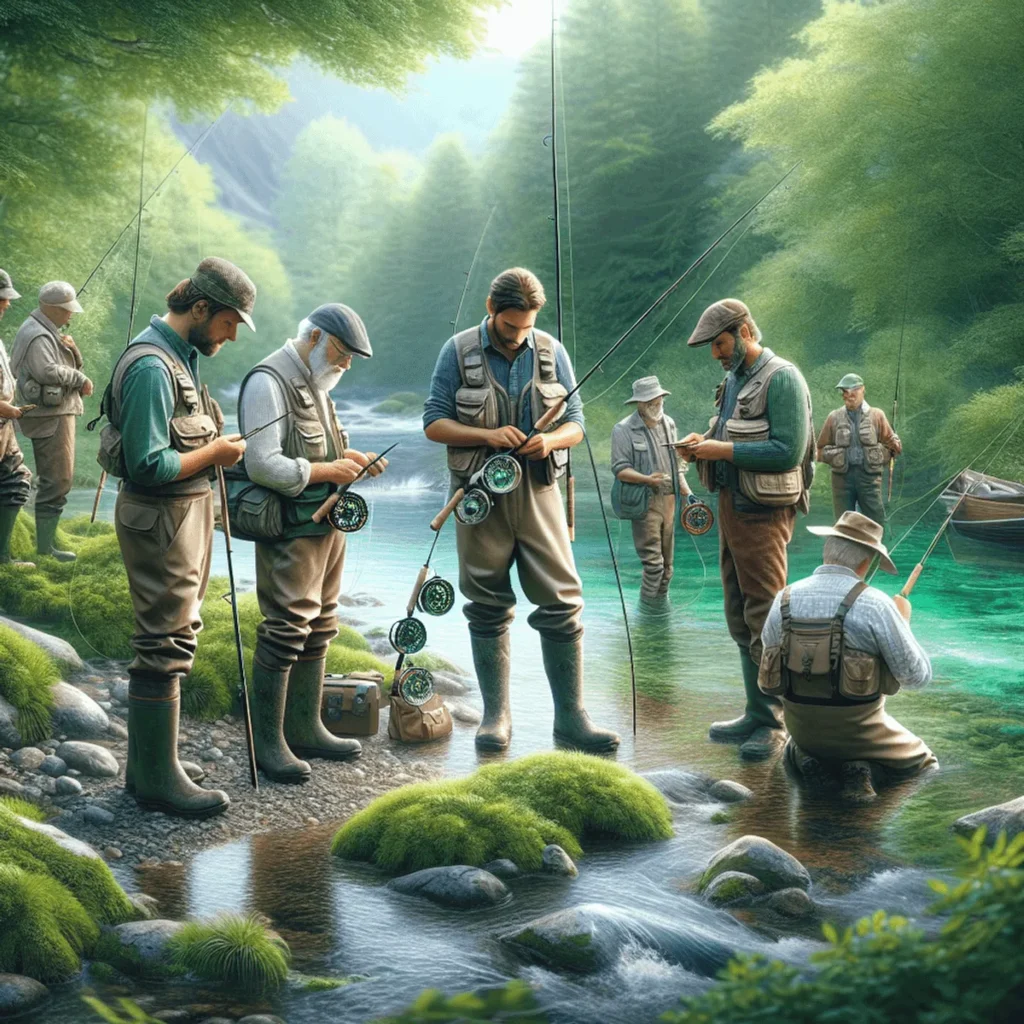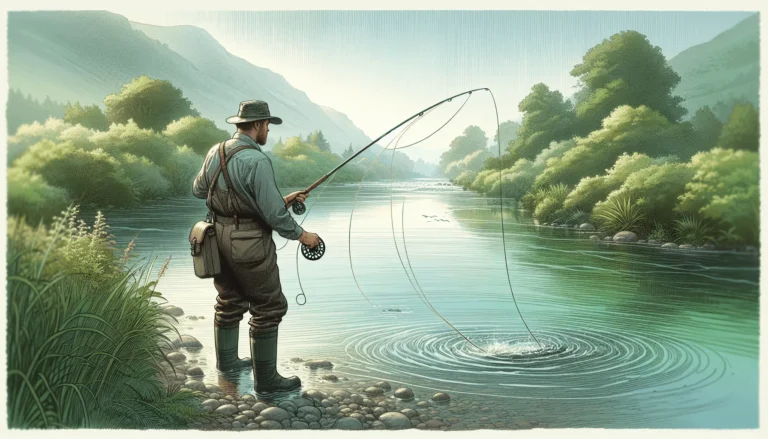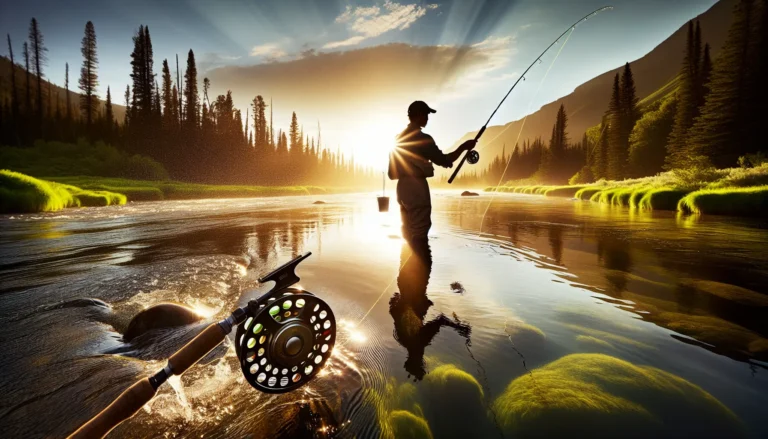Welcome to the Monic Fly Line Review, your ultimate guide for 2024. Monic Fly Lines are known for their specialized designs and commitment to quality, making them a popular choice among avid anglers. With unique features such as all-clear floating lines and species-specific tapers, Monic lines are tailored to meet various fishing conditions, whether you’re casting in freshwater or battling the surf in saltwater environments.
Choosing the right fly line is crucial for fishing success. The right line can significantly enhance your casting distance, accuracy, and overall enjoyment on the water. Each Monic fly line offers distinctive characteristics that can complement your fishing style and target species.
This review aims to provide you with comprehensive insights into Monic fly lines. You’ll discover:
- An understanding of Monic’s design philosophy
- In-depth analysis of key offerings like the Saltwater Master Series and Advanced Trout Line
- Performance evaluations based on real user experiences
- Comparisons with competitors to help you find the best fit for your needs
Whether you’re a seasoned angler looking to upgrade your gear or a newcomer eager to learn, this guide will equip you with the knowledge needed to make an informed decision about Monic fly lines.
Understanding Monic Fly Lines
Monic Fly Lines are known for their focus on both innovation and quality. They use advanced materials and technologies to improve fishing experiences in different environments. The brand also prioritizes eco-friendly solutions, like PVC-free coatings, to reduce environmental impact without sacrificing performance.
The variety within the Monic fly lines portfolio caters to diverse angling needs:
- Saltwater Master Series: These lines are crafted for saltwater conditions, featuring textured surfaces and colored lines that accommodate specific grain weights. Ideal for targeting a myriad of saltwater species, these lines offer enhanced casting accuracy and durability. This series is particularly beneficial for those looking to explore destinations like Honduras, known for its rich marine biodiversity.
- Advanced Trout Line: Specifically designed for freshwater applications, this line excels in mountain trout fishing. It’s engineered to deliver precision and sensitivity, making it a favorite among trout enthusiasts. For those who seek the thrill of trout fishing in challenging terrains, areas such as the South Island, often referred to as the Mount Everest of trout fishing, would be a perfect match.
- Henley Fly Lines: Available in clear/intermediate options with larger diameters, these lines boast excellent casting abilities while reducing coiling issues.
- Icicle Floating Fly Line: Known for its high floating capacity and environmentally conscious design, this line provides superior visibility with its textured coating.
By offering specialized products tailored to the unique demands of different fishing scenarios, Monic ensures that anglers have the tools needed for success on the water.
Key Offerings from Monic
Saltwater Master Series
Monic Fly Fishing enthusiasts often turn to the Saltwater Master Series for its specialized design tailored to diverse saltwater environments. These fly lines have colored textures that optimize grain weight ranges, making them perfect for targeting saltwater species like bonefish, tarpon, and permit. The textured surface improves casting accuracy and reduces wear, providing a reliable option for anglers navigating challenging coastal conditions.
Advanced Trout Line
The Advanced Trout Line is a standout for those pursuing mountain trout in freshwater settings. Its precise engineering offers exceptional performance in streams and rivers, where stealth and precision are critical. Anglers appreciate its low memory and smooth casting capabilities, which allow for delicate presentations essential for hooking wary trout. This line excels in environments requiring finesse and accuracy.
Icicle Floating Fly Line
For high-floating capabilities, the Icicle Floating Fly Line is a preferred choice. Designed with a textured coating that enhances visibility without PVC chemicals, this line is both environmentally conscious and effective. Its buoyant nature makes it ideal for fishing on calm lakes or slow-moving rivers, where maintaining a visible line above water can be advantageous.
These offerings from Monic cater to diverse fishing conditions, providing specialized solutions whether you’re chasing saltwater giants or seeking the subtlety needed for freshwater trout. Each line’s unique features align with specific species and habitat requirements, ensuring you have the right tool for successful fly fishing adventures.
Performance Analysis of Monic Fly Lines

Understanding the performance metrics of Monic Fly Lines is crucial for any angler looking to optimize their fishing experience. Key performance features such as stretchiness, sensitivity during use, and resistance to breakage play a significant role in determining the overall effectiveness of these lines.
Stretchiness
Monic Fly Lines are designed to offer minimal stretch, which enhances hook-setting capabilities. This low stretch characteristic ensures more direct contact with the fly, allowing for improved control and responsiveness during casts and retrieves.
Sensitivity
The lines are engineered to maximize sensitivity, providing an exceptional feel for subtle strikes. This heightened sensitivity is particularly beneficial when targeting wary species or fishing in challenging conditions where precise feedback from the line is essential.
Resistance to Breakage
Durability remains a focal point in the Monic Fly Line review. The lines are constructed with high-quality materials aimed at resisting breakage under tension. Despite this, some users have reported variability in durability across different batches, highlighting the importance of regular inspection and maintenance.
These features collectively contribute to a distinct fishing experience with Monic Fly Lines. Whether you’re casting in saltwater or freshwater environments, understanding these attributes can help you make more informed decisions about your equipment choices.
User Experiences with Monic Fly Lines
Exploring user experiences with Monic Fly Lines reveals a tapestry of mixed reviews from the angling community. Many anglers appreciate the lines’ unique features, such as low memory and ease of casting, which contribute to enjoyable fishing sessions. These characteristics often translate into improved casting accuracy and distance, making them a popular choice among those targeting various species.
However, the conversation shifts when addressing durability and performance consistency over time. Some users express concerns regarding the longevity of these lines, noting that they can show signs of wear quicker than expected under certain conditions. For instance:
- Durability Concerns: Anglers have reported varying degrees of line fraying and wear, particularly when used in abrasive environments or against rough surfaces.
- Performance Consistency: While some batches exhibit excellent performance out of the box, others seem to fall short, leading to questions about manufacturing consistency.
These mixed reviews underscore the importance of regular maintenance and care, as highlighted by experienced users who emphasize practices like line dressing to prolong life and maintain optimal performance. The diverse experiences shared by anglers offer valuable insights for potential buyers considering Monic Fly Lines for their next fishing adventure.
Comparing Monic Fly Lines to Competitors

When comparing Monic Fly Lines to competitors, several factors come into play, including pricing, performance features, and unique characteristics. Popular brands like Cortland’s Liquid Crystal, Rios, and Scientific Anglers (SA) often come up in discussions among anglers.
Cortland’s Liquid Crystal:
- Pricing: Generally competitive with Monic Fly Lines.
- Standout Characteristics: Known for their durability and low-stretch properties, offering consistent performance for saltwater anglers. The Liquid Crystal series is praised for its ability to handle harsh environmental conditions without significant wear.
Rios:
- Pricing: Slightly higher than Monic in some cases but justified by a reputation for high-quality craftsmanship.
- Standout Characteristics: Offers a wide range of lines tailored for specific species and fishing techniques. Rios fly lines are recognized for their versatility and precision in casting, making them a favorite among professional anglers.
Scientific Anglers (SA):
- Pricing: Comparable to Monic, with some premium lines priced higher.
- Standout Characteristics: Known for innovative technologies such as AST Plus slickness additive, which enhances durability and reduces friction. SA lines often feature complex tapers designed to optimize performance across diverse fishing scenarios.
Monic Fly Lines distinguish themselves with features such as low memory levels and eco-friendly materials. While they provide excellent value concerning price and unique design philosophies, each competitor offers its own set of advantages that might appeal differently depending on your specific angling needs.
Strengths and Weaknesses of Monic Fly Lines
Strengths
One standout feature of Monic Fly Lines is their low memory levels. This characteristic significantly enhances casting ease, allowing for smoother line movement and reducing tangling issues. Anglers frequently praise Monic lines for their ability to maintain shape, which is crucial for accurate casting and efficient line control.
Another notable strength lies in the lines’ design precision. Monic’s commitment to crafting species-specific tapers means that their lines are tailored for optimal performance in various fishing conditions. The textured coatings on certain models also contribute to improved visibility and reduced environmental impact due to the absence of PVC chemicals.
Weaknesses
However, there are weaknesses to consider. Durability concerns have been raised by users who reported inconsistencies in performance across different batches. Some anglers have experienced wear and tear under specific environmental conditions, such as extreme temperatures or abrasive terrains. This inconsistency can affect the line’s longevity and reliability during prolonged use.
It’s worth noting that while Monic Fly Lines offer several advantages, they may not be the best fit for every angler’s needs. For instance, those who prefer a more traditional approach might find value in exploring options like the Cortland braided mono running line, which has its own unique strengths.
Balancing these strengths and weaknesses is essential when evaluating whether Monic Fly Lines align with your fishing needs. Acknowledging these factors provides a comprehensive understanding of what to expect when investing in these lines, aiding in making an informed decision tailored to your angling pursuits.
Fishing Techniques with Monic Fly Lines
Using different Monic Fly Lines in freshwater and saltwater environments means adjusting your fishing techniques to get the best results. Each line is designed for specific fishing styles and conditions, so it’s important to know how to make the most of these features.
Freshwater Techniques
- Advanced Trout Line: Perfect for mountain trout fishing, this line is great for precise casting. Its low memory levels allow for smooth, accurate presentations in tight spots. When going after trout, using a delicate presentation with dry flies or nymphs increases your chances of success. Focus on short to medium casts, staying stealthy to avoid scaring the fish. Additionally, consider implementing the mono rig technique for enhanced performance.
Saltwater Techniques
- Saltwater Master Series: This line is designed for saltwater fish like bonefish. The textured surface helps with long-distance casting needed in open flats, where bonefish are often found. Use double-haul casting techniques to increase line speed and distance, making it easier to reach cruising fish without disturbing the water surface.
- Icicle Floating Fly Line: Known for its high floating abilities, it supports visibility and control in estuarine environments. This line is great for topwater action when sight-fishing. Practice strip-and-pause retrieves to imitate prey movements effectively, catching the attention of predators.
By choosing the right Monic Fly Line and technique, anglers can ensure optimal performance whether casting in calm freshwater streams or challenging saltwater areas.
Maintenance Tips for Optimal Performance
To keep your Monic Fly Lines in top shape, you need to pay attention to details and take care of them regularly. Here are some important maintenance tips to make sure your lines work their best:
1. Apply Line Dressing
Using line dressing can:
- Reduce noise during use
- Improve casting efficiency
- Treat the surface of the line for better glide through guides
- Extend the lifespan of your lines
2. Store Properly to Avoid Coiling and Tangling
To prevent coiling or tangling issues, store your lines correctly by loosely winding them around a large spool or reel. This practice helps maintain a smooth line memory, which is crucial for easy casting.
3. Clean Regularly
After each fishing trip, especially in saltwater environments, rinse your fly lines with fresh water. Salt residues can degrade the material over time, affecting performance and durability.
4. Inspect for Damage
Regularly check for nicks or abrasions along the line’s length. Early detection allows you to address minor issues before they become significant problems.
By incorporating these simple yet effective maintenance routines into your gear care routine, you ensure that your Monic Fly Lines remain reliable companions on every fishing adventure.
Alternatives to Consider
Exploring alternatives to Monic Fly Lines can broaden your options as an angler looking for lines that cater to specific needs. Here are some alternatives worthy of consideration:
- Cortland’s Liquid Crystal Series: Known for its durability and smooth casting ability, this series is a favorite among saltwater anglers. Its unique crystal-clear design minimizes visibility in water.
- Rio Gold Fly Line: This line offers a perfect balance between distance and accuracy. With a reputation for impressive loop stability at significant distances, it suits both beginners and seasoned anglers.
- Scientific Anglers (SA) Mastery Series: Praised for its advanced taper design, the SA Mastery Series provides exceptional performance across various fishing conditions, especially in freshwater scenarios.
These options present features like low stretch, high sensitivity, and varying taper profiles that enhance the fishing experience in diverse environments. Each brand brings something unique to the table, highlighting the need for anglers to consider their individual preferences and fishing contexts when selecting the right line.
Conclusion
Investing in Monic Fly Lines can be a smart choice for anglers looking to improve their fishing experience in 2024. These lines have specialized designs that are perfect for different fishing conditions and species, giving you advantages like less tangling and easier casting. However, it’s important to also think about how durable they are and if they perform consistently. Taking care of them regularly can help with some problems, making sure you get the most value for your money. Ultimately, whether or not they’re worth it depends on if these benefits match your fishing needs.
FAQs (Frequently Asked Questions)
What are Monic Fly Lines and what makes them unique?
Monic Fly Lines are specially designed fishing lines that emphasize quality and performance. Their unique features include low memory levels for easier casting, sensitivity during use, and resistance to breakage, making them a preferred choice among anglers.
How do I choose the right Monic Fly Line for my fishing needs?
Choosing the right Monic Fly Line depends on the target species and fishing conditions. For instance, the Saltwater Master Series is ideal for saltwater species, while the Advanced Trout Line is tailored for freshwater trout fishing. Understanding your specific requirements will help you select the best line.
What are some popular models of Monic Fly Lines?
Some of the popular models include the Saltwater Master Series, Advanced Trout Line, and Icicle Floating Fly Line. Each of these lines excels in different fishing conditions and target species, providing options suitable for various angling scenarios.
How do Monic Fly Lines perform in terms of stretchiness and durability?
Monic Fly Lines are designed to have optimal stretchiness which enhances sensitivity during use. However, there have been mixed reviews regarding their durability under specific environmental conditions, so it’s important to consider your fishing environment when selecting a line.
How do Monic Fly Lines compare to other brands?
When compared to competitors like Cortland’s Liquid Crystal, Rios, and SA, Monic Fly Lines offer competitive pricing along with standout characteristics such as low memory levels. However, individual experiences may vary based on personal preferences and specific fishing conditions.
What maintenance tips can help prolong the life of my Monic Fly Line?
To maintain your Monic Fly Line effectively, regularly dress the line to reduce noise during use and prevent coiling or tangling. Regular upkeep is essential for enhancing longevity and ensuring optimal performance over time.




